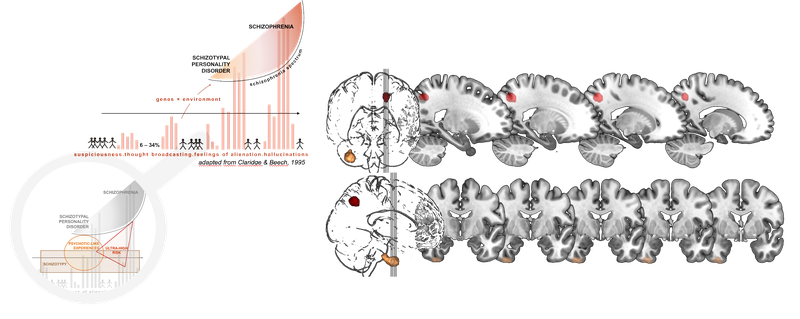Main Content
Research
The focus of our lab's work is on dimensional and dynamic approaches to mental health. Human traits and behaviours are central to risk of emerging psychopathology and they influence the well-being of individuals.
Subclinical characteristics of psychiatric disorders are (to varying degrees) frequently occuring within healthy populations, challenging the traditional concept of health versus disease as discrete states. To account for this, categorical models of health and disease are also more and more superseded by dimensional models (or hybrid models, combining properties of both). We realise the importance of risk phenotypes or risk traits across the general population and their relevance for understanding psychiatric disorders as well as resilience, and apply these concepts in our approach to neuroimaging research. Many of these phenotypes are dynamic, so studying the emergence of high-risk states is a second focus of our work (e.g. ultra-high risk states for psychosis).

Current work covers multiple areas:
Inhalt ausklappen Inhalt einklappen Dynamic Brain Network Models in Cognitive Neuropsychiatry

The network focus of our group is aimed at studying defined circuits that are important for the emergence of symptoms as well as maintenance of well-being. Using both structural and functional MRI, we identify networks showing a relation to risk traits or risk stages of disease. Previous and current studies have included analyses on the psychosis spectrum, the affective spectrum, autistic-like and narcissistic traits.
Inhalt ausklappen Inhalt einklappen Dimensional approaches to affective disorders and the psychosis spectrum

Dimensional psychiatry considers overlaps and transitions between disorders, prodromal states, risk status, and health. Dimensionality therefore refers to both the overlap between defined disorders (e.g. schizophrenia and affective disorders, or psychosis and autism spectrum disorders), as well as the dimension of a disease spectrum ranging from health over minute expressions of symptoms or risk factors over risk stages and manifest psychiatric disorders. Our work has analysed overlaps of disease spectra on the phenotype level as well as the level of brain structure and function.
Meller, T., Schmitt, S., Ettinger, U., Grant, P., Stein, F., Brosch, K., Grotegerd, D., Dohm, K., Meinert, S., Förster; K., Hahn, T., Jansen, A., Dannlowski, U., Krug, A., Kircher, T. & Nenadic, I. (2022). Brain structural correlates of schizotypal signs and subclinical schizophrenia nuclear symptoms in healthy individuals. Psychological Medicine, 52(2), 342-351.
Inhalt ausklappen Inhalt einklappen Cognitive Neuropsychiatry and dynamic social networks

Social interaction is a central element of the human experience and many disorders (as well as risk states) involve impairments in social functions. Both in the general population and in psychiatric patients, social (dys)functioning predicts mental and physical health as well as quality of life. Social functions, such as communication, social interaction and organization, are complex behavioral processes that are under the control and modulation of specific neuronal networks. There is evidence that the integrity of these networks is also impaired in the psychosis spectrum and other psychiatric disorders.
Current projects of lab members analyse the relation of structural and functional brain “social networks” to risk spectra, such as schizotypy (a set of stable, schizophrenia-like personality traits) and autism-spectrum characteristics, as well as risk phenotypes related to social dominance and subordination (e.g. grandiose vs. vulnerable narcissistic traits). Interactions with deficits in emotion regulation have been outlined which are assumed to serve as a transdiagnostic construct for affective and personality disorders.
Schmidt, L., Pfarr, J.K., Meller, T., Evermann, U., Nenadic, I. (2023). Structural connectivity of grandiose versus vulnerable narcissism as models of social dominance and subordination. Manuscript submitted for publication. Cognitive Neuropsychiatry. Philipps University Marburg